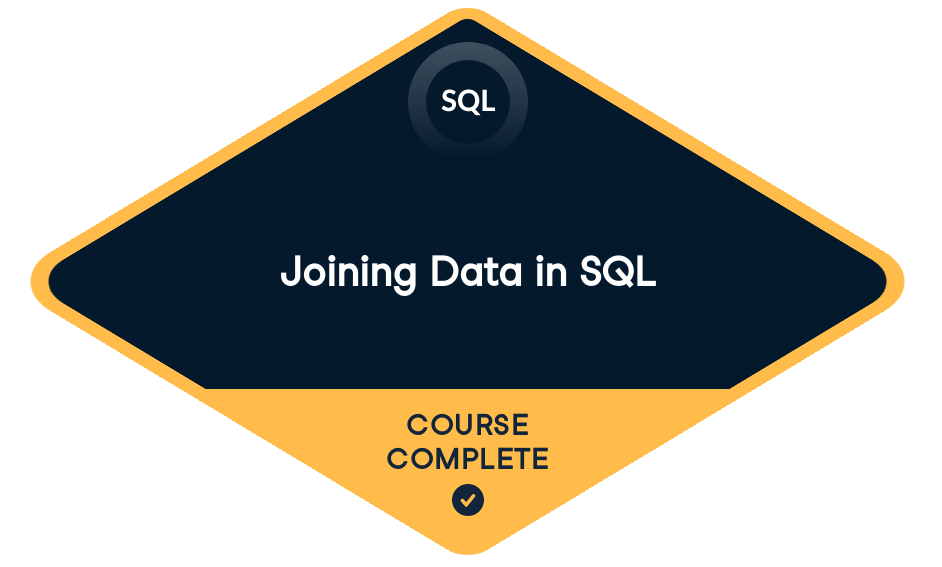
Loved by learners at thousands of companies
Course Description
Joining data is an essential skill in data analysis, enabling you to draw information from separate tables together into a single, meaningful set of results. In this comprehensive course on joining data, you'll delve into the intricacies of table joins and relational set theory, learning how to optimize your queries for efficient data retrieval.
Understand Data Joining Fundamentals
You will learn how to work with multiple tables in SQL by navigating and extracting data from various tables within a SQL database using various join types, including inner joins, outer joins, and cross joins. With practice, you'll gain the knowledge of how to select the appropriate join method.Explore Advanced Data Manipulation Techniques
Next up, you'll explore set theory principles such as unions, intersects, and except clauses, as well as discover the power of nested queries in SQL. Every step is accompanied by exercises and opportunities to apply the theory and grow your confidence in SQL.For Business
Training 2 or more people?
Get your team access to the full DataCamp library, with centralized reporting, assignments, projects and more- 1
Introducing Inner Joins
FreeIn this chapter, you’ll be introduced to the concept of joining tables and will explore all the ways you can enrich your queries using joins—beginning with inner joins.
- 2
Outer Joins, Cross Joins and Self Joins
After familiarizing yourself with inner joins, you will come to grips with different kinds of outer joins. Next, you will learn about cross joins. Finally, you will learn about situations in which you might join a table with itself.
LEFT and RIGHT JOINs50 xpRemembering what is LEFT100 xpThis is a LEFT JOIN, right?100 xpBuilding on your LEFT JOIN100 xpIs this RIGHT?100 xpFULL JOINs50 xpComparing joins100 xpChaining FULL JOINs100 xpCrossing into CROSS JOIN50 xpHistories and languages100 xpChoosing your join100 xpSelf joins50 xpComparing a country to itself100 xpAll joins on deck100 xp - 3
Set Theory for SQL Joins
In this chapter, you will learn about using set theory operations in SQL, with an introduction to UNION, UNION ALL, INTERSECT, and EXCEPT clauses. You’ll explore the predominant ways in which set theory operations differ from join operations.
- 4
Subqueries
In this closing chapter, you’ll begin by investigating semi-joins and anti-joins. Next, you'll learn how to use nested queries. Last but not least, you’ll wrap up the course with some challenges!
Subquerying with semi joins and anti joins50 xpMultiple WHERE clauses100 xpSemi join100 xpDiagnosing problems using anti join100 xpSubqueries inside WHERE and SELECT50 xpSubquery inside WHERE100 xpWHERE do people live?100 xpSubquery inside SELECT100 xpSubqueries inside FROM50 xpSubquery inside FROM100 xpSubquery challenge100 xpFinal challenge100 xpThe finish line50 xp
For Business
Training 2 or more people?
Get your team access to the full DataCamp library, with centralized reporting, assignments, projects and moreCollaborators



Prerequisites
Intermediate SQLMaham Khan
See MoreSenior Data Scientist, YouView TV
Maham is a Data Scientist on a mission to make data skills accessible for everyone. She's worked on creating toolkits and exploring experimental applications of data science for urban analytics, disaster risk management, and climate change mitigation at the World Bank. She has a background in Experimental Psychology and Philosophy from the University of Oxford and Urban Data Science from NYU.
Join over 13 million learners and start Joining Data in SQL today!
Create Your Free Account
or
By continuing, you accept our Terms of Use, our Privacy Policy and that your data is stored in the USA.